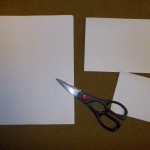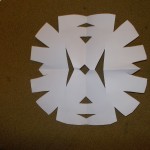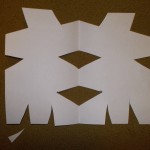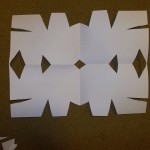Symmetry and Snowflakes
Do you remember the day you were told that each and every snowflake in the entire world is unique and that no two snowflakes are alike? The idea of infinite possibilities still rattles my brain. How can each of the billions and billions of snowflakes be unique?
Spatial awareness or concepts about space and shape, are pretty interesting to young children. Snowflakes are one way to explore shape in an engaging and meaningful way, especially if you live in a part of the world that is filled with the cold, white stuff a good part of the year. Also, as children begin working on their cutting-with-scissors skills, creating snowflakes is great way to practice. Some kinds of paper are harder to cut than others but the easiest paper to cut is also the most likely to tear. I like simple copy paper for snowflakes as it is sturdy enough to withstand some three-year old torture, but light enough to cut easily with children’s scissors.
Begin by folding the paper in half and then in half again.  The difficulty in cutting increases with the number of folds, so fold the paper to meet each child’s individual developmental needs. One fold reveals the least interesting patterns and more folds reveals more complicated designs. Ask the children about the shapes they have created. Show them that they can fold the paper back up and continue cutting, if they so choose. The snowflakes will just become more interesting.
The difficulty in cutting increases with the number of folds, so fold the paper to meet each child’s individual developmental needs. One fold reveals the least interesting patterns and more folds reveals more complicated designs. Ask the children about the shapes they have created. Show them that they can fold the paper back up and continue cutting, if they so choose. The snowflakes will just become more interesting.
If you want them to look more like snowflakes, and you think the children may enjoy it, you can begin with circular paper. Again, fold at will, but the thicker the folded paper is, the more difficult it is to cut. 

If you are working with older children, snowflakes are also a great place to discuss symmetry. They provide concrete examples of “mirror images” that are easily (maybe not easily) seen. Notice how unique and distinct each of the children’s snowflakes are. No two are alike and that is what makes them special.


Do this every year and the kids love the different shapes
I really enjoy this and think I could even use this with my older two year old children 🙂